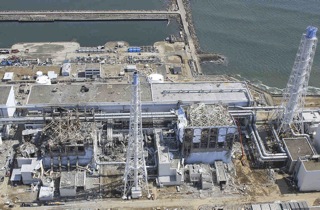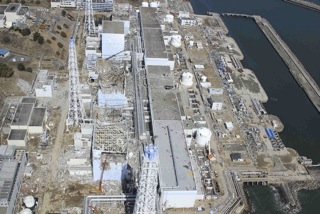Hydrogen Explosions in Nuclear Reactors and a Passive Way to Prevent Them
By: Robert E. Buxbaum, REB Research & Consulting co
The explosions that happened recently at the Fukushima Daiichi nuclear plants were hydrogen explosions. As president of a hydrogen products company, I thought it worthwhile to write an essay on where the hydrogen comes from, and on a specialty hydrogen transport membrane we've been selling for the last ten years for passive nuclear safety in these plants. This is a product to lessen the likelihood of hydrogen explosion and to reduce the likelihood of radioactive release in case of an accident; it could also help cleanup after an accident.
The Fukushima Daiichi reactors, like most nuclear reactors, are made of metal and cooled by water. In the Mark 1 (3 and 4) design the metals are a combination of zirconium alloy for the rods, and stainless steel for the main assembly. These metal components were cooled by boiling light water, H2O; many other reactors, particularly in Canada, are cooled by heavy water, D2O, and some newer reactors are cooled by non-boilihng light water. Whatever the metal, and whatever type of water is used to cool it, all nuclear-reactor metals will corrode in water at some rate in the presence of intense radiation and hot water or steam. This corrosion goes on continuously, and usually quite slowly, forming a metal oxide, usually adherent, and hydrogen gas. Corrosion is worse during a nuclear accident where cooling power is diminished and temperatures are higher, but hydrogen-producing corrosion is a normal part of all reactors, occurring even when the reactors are shut down.
 Hydrogen from the corrosion enters the liquid or steam coolant where, for the most part, it is merely a nuisance. The hydrogen contributes to decreased efficiency, as well hydrogen embrittlement and swelling of the nuclear metals; that is a reduction n the power output and a shortening of the reactor life. Hydrogen induces excess pressure in the steam line equal to the partial pressure of the hydrogen; in boiling water reactors like the Mark 1, it also interferes with the low pressure condenser, and also in general in the rate of heat transfer from the steam. Because of these nuisances, every now and again the hydrogen is vented. Venting is a normal part of reactor operation; a small amount of (slightly radioactive) hydrogen-steam mix is released from a cooler part of the line, and the hydrogen pressure is reduced. Ideally, this hydrogen-steam mix is captured before it reaches the environment, but for a light water reactor during normal operation, the mix is so mildly radioactive that most plant licenses allow a small amount of venting directly to the environment without further cleanup. Occasional, small explosions are not uncommon since the steam contains a significant content of hydrogen, and hydrogen is quite explosive.
Hydrogen from the corrosion enters the liquid or steam coolant where, for the most part, it is merely a nuisance. The hydrogen contributes to decreased efficiency, as well hydrogen embrittlement and swelling of the nuclear metals; that is a reduction n the power output and a shortening of the reactor life. Hydrogen induces excess pressure in the steam line equal to the partial pressure of the hydrogen; in boiling water reactors like the Mark 1, it also interferes with the low pressure condenser, and also in general in the rate of heat transfer from the steam. Because of these nuisances, every now and again the hydrogen is vented. Venting is a normal part of reactor operation; a small amount of (slightly radioactive) hydrogen-steam mix is released from a cooler part of the line, and the hydrogen pressure is reduced. Ideally, this hydrogen-steam mix is captured before it reaches the environment, but for a light water reactor during normal operation, the mix is so mildly radioactive that most plant licenses allow a small amount of venting directly to the environment without further cleanup. Occasional, small explosions are not uncommon since the steam contains a significant content of hydrogen, and hydrogen is quite explosive.
The explosions that removed the roofs of Daiichi reactors 1, 2, and 3 were much larger scale versions of the normal venting explosions. The fuel and water in the reactors became heated beyond their normal limits when the cooling pumps shut down; the high temperatures that resulted led to accelerated corrosion rates, the hydrogen output and pressure increased beyond its normal limits, and eventually heat transfer was severely compromised, and corrosion accelerated. A much larger amount of steam-hydrogen was released eventually by an automatic pressure relief valve, and the large hydrogen content meant that the explosion that resulted went off with a lot more force than is normally seen. To make matters worse, in some of the Daiichi reactors, the released steam was quite a lot more radioactive than normally seen. The top of the fuel rods appear to have melted releasing radioactive iodine and cesium from the fuel itself into the steam hydrogen mix. The main radiation worry today is from these radioisotopes, as they were scattered with the exploding hydrogen, and then with the winds over the plant. Cleanup will take many years, and may preclude restarting the reactors, or nearby habitation for years to come.
As bad as the consequences are, the hydrogen release was very good for the safety of the entire Fukushima Daiichi nuclear plant. As with the lancing of a boil, the release of this hydrogen-mix prevented the pressures from reaching levels that could destroy the reactor vessel and spread much worse radiation, as seen in Chernobyl. Also, the hydrogen removal process improved the heat transfer properties of the steam inside the reactor, allowing a degree of passive cooling, even where the pumps were not working. Still, it is desirable to find a less-destructive way to release the hydrogen pressure - Ideally one that acts as a passive safety and does not result in an explosion, while preventing the release of steam, cesium, plutonium, and iodine along with the hydrogen.

We've been making and selling hydrogen extraction membranes to do this for the last ten years or so, and REB Research holds a US patent. So far they have been approved by the European Nuclear cmommision, and seem to work well. What they are is a 100% selective, high-pressure, low-temperature, hydrogen-extraction membrane capable of extracting hydrogen from steam at pressures up to 1500 psi and temperatures between room temperature and 500C. These have been tested in a variety of nuclear reactor simulations and have been found to extract hydrogen well. During normal operation, hydrogen in the steam diffuses through the membrane material at a controlled rate and oxidizes to water on the Pd-coated downstream side of the membrane. Because the membrane is 100% selective to hydrogen no steam or other atoms leave with the hydrogen and the radioactive release rate is greatly diminished. Further, since the hydrogen removal is continuous and small, the chance of an explosion is significantly diminished. As an added bonus, continuous hydrogen removal increases the efficiency of the turbines by decreasing the low pressures available in the condenser. Finally hydrogen removal increases the heat transfer qualities of the condensing steam. Condensing steam transfers heat through a passive mechanism that's sometimes called heat piping, where the energy of the heat is carried by convective flow of the saturated steam. When hydrogen is present, it blocks the flow of steam to the cooler parts of the condenser decreasing the rate of heat removal; our membranes remove the hydrogen and allow the steam more direct contact with the condenser serfaces.
During a loss of cooling power accident, as happened in Japan, the rate of hydrogen production is increased along with the temperature and hydrogen partial pressure. As a result the rate of hydrogen removal through the membrane would increase from its normal, low rate. As with normal operation, removal of hydrogen reduces the pressure in the steam and increases rate of passive heat removal. These two effects decrease the chance of a meltdown. During an accedent, much of the heat transfer is through the reactor housing, but the effect is the same. The heat transfer capabilities of a steam hydrogen mix increases significantly as the hydrogen is removed. Removing the hydrogen means that the is less inert gas in the way to block the flow of steam to the cooler parts of the reactor vessel; the water ends up cooler than it would be otherwise, and corrosion is decreased; the result is that the chances of a meltdown or explosion is reduced.
Membranes of this sort appear in the specialty section of our catalog.
© Robert Buxbaum, 2011